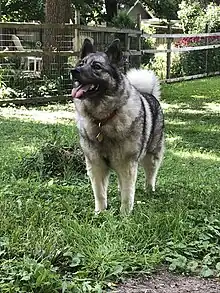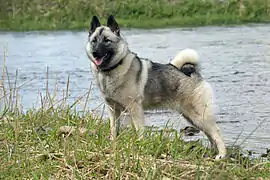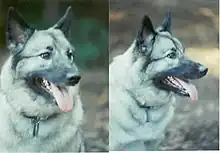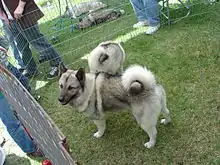Norwegian Elkhound
The Norwegian Elkhound is one of the Northern Spitz-type breeds of dog and is the National Dog of Norway. The Elkhound has served as a hunter, guardian, herder, and defender. It is known for its courage in tracking and hunting elk and other large game, such as bears or wolves.[1][2] The Norwegian Elkhound was first presented at a dog exhibition in Norway in 1877.
| Norwegian Elkhound | |||||||||
|---|---|---|---|---|---|---|---|---|---|
 A female Norwegian Elkhound, showing the standard tightly curled tail | |||||||||
| Other names | Norsk elghund Grå norsk elghund Gray Norwegian Elkhound Small Grey Elk Dog Norwegian Moose Dog Harmaa norjanhirvikoira | ||||||||
| Origin | Norway | ||||||||
| |||||||||
| Notes | The FCI divides this into two breeds, Grey (242) and Black (268). | ||||||||
| Dog (domestic dog) | |||||||||
The AKC breed name "Norwegian Elkhound" is mistranslated from its original Norwegian name Norsk elghund, meaning "Norwegian moose dog". In Norwegian "elg" means "moose" and "hund" means "dog," as it does in many other Germanic languages. It is Spitz breed, not a "hound" dog. The breed's object in the hunt is to independently track down and hold the moose at bay—jumping in and out toward the moose, distracting its attention, while signaling to the hunters by barking very loudly—until the hunter who follows the sound can arrive to shoot it. The dog will only bark while the moose is stationary, but it can also slowly drive the moose towards shooters lying in wait. The Norwegian Elkhound is also used on a leash. In this mode of hunting, the dog leads the hunter in the direction of the moose while keeping quiet.
Lineage
The breed falls under the mitochondrial DNA sub-clade referred to as d1 that is only found in northern Scandinavia. It is the result of a female wolf-male dog hybridization that occurred post-domestication.[3][4] Subclade d1 originated "at most 480–3,000 years ago" and includes all Sami-related breeds: Finnish Lapphund, Swedish Lapphund, Lapponian Herder, Jämthund, Norwegian Elkhound and Hällefors Elkhound. The maternal wolf sequence that contributed to these breeds has not been matched across Eurasia[5]
Description
Appearance
| Norwegian Elkhound appearance | ||
|---|---|---|
| Build: | medium, sturdy and squarely built | |
| Weight: | 44-51 lbs (20–23 kg) | |
| Height: | 19.5–20.5 inches (50–52 cm) | |
| Coat: | Coarse, straight, with soft undercoat | |
| Color: | Black and white coloring, often noted as grey or silver | |
| Head: | Broad and wedge-shaped with a defined stop | |
| Teeth: | Scissors bite | |
| Eyes: | Dark brown with a keen, friendly expression | |
| Ears: | Pointed, erect | |
| Tail: | Rolled tightly over back | |
| Limbs: | Straight and parallel | |
| Life span: | 14–16 years | |

According to The Kennel Club breed standard ideally the dog stands about 19.5–20.5 inches (50–52 cm) high and weighs up to 23 kilograms (51 lb).[6] Its grey, white, and black coat is made up of two layers: an underlying dense smooth coat ranging from black at the muzzle, ears, and tip of its tail to silvery grey on its legs, tail, and underbody and an overlying black-tipped protective guard coat. An ideal Elkhound has a tightly curled tail. The Elkhound is a medium-sized dog and extremely hardy.
Temperament

Norwegian Elkhounds are bred for hunting large game, such as wolf, bear and moose. Although the breed is strong and hardy, the dogs typically have an inseparable bond with their masters and are quite loyal. All Elkhounds have a sharp loud bark which makes them suitable as watchdogs.
Norwegian Elkhounds are loyal to their "pack" and make excellent family dogs given proper attention. They are bold, playful, independent, alert, extremely intelligent, and, at times, a bit boisterous. They rank 54th in Stanley Coren's The Intelligence of Dogs, being of above average working/obedience intelligence.

Health
Norwegian Elkhounds sometimes carry a genetic predisposition to suffer from progressive retinal atrophy, or, like many medium and large breeds, hip dysplasia, renal problems, and cysts, particularly in later life; they are also prone to thyroid problems. Overall, however, they are a hardy breed with few health problems.
Elkhounds are prone to rapid weight gain and must not be overfed.
They have a lifespan of 12–16 years. There have been reports of elkhounds living to be 18 years old and older.
History
In Medieval times, it was known as a dyrehund, meaning "animal-dog" in Norwegian, and was highly prized as a hunting dog but rarely seen or bred outside of Norway until its appearance in England in the 19th century.[7] It was officially recognized by The Kennel Club in 1901.
Famous Norwegian Elkhounds
- President Herbert Hoover's "Weegie"
See also
References
- Citations
- "Norwegian Elkhound". American Kennel Club.
- Miner, Edward Herbert. "Norwegian elkhounds hunt elk, bear, wolves and mountain lions (colour litho)". Bridgeman Education - National Geographic Image Collection (Colour Litograph).
- Pang, J.-F.; Kluetsch, C.; Zou, X.-J.; Zhang, A.-b.; Luo, L.-Y.; Angleby, H.; Ardalan, A.; Ekstrom, C.; Skollermo, A.; Lundeberg, J.; Matsumura, S.; Leitner, T.; Zhang, Y.-P.; Savolainen, P. (2009). "MtDNA Data Indicate a Single Origin for Dogs South of Yangtze River, Less Than 16,300 Years Ago, from Numerous Wolves". Molecular Biology and Evolution. 26 (12): 2849–64. doi:10.1093/molbev/msp195. PMC 2775109. PMID 19723671.
- Duleba, Anna; Skonieczna, Katarzyna; Bogdanowicz, Wiesław; Malyarchuk, Boris; Grzybowski, Tomasz (2015). "Complete mitochondrial genome database and standardized classification system for Canis lupus familiaris". Forensic Science International: Genetics. 19: 123–129. doi:10.1016/j.fsigen.2015.06.014. PMID 26218982.
- Klütsch, C.F.C.; Savolainen, Peter (2011). "Regional occurrence, high frequency, but low diversity of mitochondrial dna haplogroup d1 suggests a recent dog-wolf hybridization in Scandinavia". Journal of Veterinary Behavior: Clinical Applications and Research. 6 (1): 100–3. doi:10.1016/j.jveb.2010.08.035.
- "Breed standard". The Kennel Club. Archived from the original on 12 June 2018. Retrieved 3 June 2015.
- Antonsen, Ellinor (1995). Den norske hundeboka (in Norwegian). Sunndalsøra: Ulvund tekst & forlag. p. 170. ISBN 8291132054.
- Bibliography
- Lynch, Deborah and Jenny Madeoy. 2004 "Man's best research guide: Breeds hold key to shared ailments." presented at the annual meeting of the American Association for the Advancement of Science by Deborah Lynch of the Canine Studies Institute in Aurora, Ohio and Jenny Madeoy of the Fred Hutchinson Cancer Centre in Seattle.
- Lynch, Deborah and Jenny Madeoy. 2004a "How top dogs took lead 7,000 years ago." presented at the annual meeting of the American Association for the Advancement of Science conference in Seattle by Deborah Lynch of the Canine Studies Institute in Aurora, Ohio and Jenny Madeoy of the Fred Hutchinson Cancer Centre in Seattle.
Further reading
- Books
- Norwegian Elkhound (Comprehensive Owner's Guide), 2005. ISBN 978-1-59378-306-8
- Norwegian Elkhounds by Anna Katherine Nicholas. TFH, 1997. ISBN 978-0-7938-2319-2
- The Norwegian Elkhound (Pure Bred) by Nina P. Ross, PhD. Doral, 1995. ISBN 978-0-944875-39-1
- The Elkhound in the British Isles by Anne Roslin-Williams. Witherby & Co., 1993. ISBN 1-85609-050-7
- My 60 Years with Norwegian Elkhounds by Olav P. Campbell, 1988.
- The New Complete Norwegian Elkhound, revised edition, by Olav Wallo. Howell, 1987.
- Norwegian Elkhounds by Anna Katherine Nicholas. TFH, 1983.
- Great Gray Dogs: The Norwegian Elkhound Factbook, 2nd edition. Great Gray Dogs, 1980.
- Your Norwegian Elkhound by Helen E. Franciose and Nancy C. Swanson. Denlinger, 1974.
- How to Raise and Train a Norwegian Elkhound by Glenna Clark Crafts. TFH, 1973. Reprint of the 1964 book with a different cover.
- Magazine Articles
- Dearth, Kim D.R. "The Norwegian Elkhound" Dog World September 1999, Vol. 84 Issue 9, p12-17.
- "Dog of the Vikings" Dog Fancy. April 1998.
- "Norwegian Elkhound". Dog World. July 1997, Vol. 82 Issue 7. p86.
- "Regional occurrence, high frequency but low diversity of mitochondrial DNA haplogroup d1 suggests a recent dog-wolf hybridization in Scandinavia". Klütsch CFC, Seppälä EH, Lohi H, Fall T, Hedhammar Å, Uhlén M, Savolainen P 2010 Animal Genetics, online early.